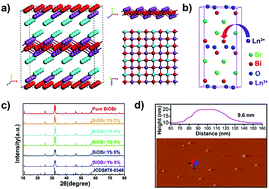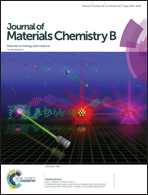Lanthanide-doped bismuth oxobromide nanosheets for self-activated photodynamic therapy†
Abstract
Low tissue penetration depth of the excited light and complicated synthetic procedures greatly hinder the clinical application of photodynamic therapy (PDT). Here we present a facile and mass production route to fabricate Yb3+/Tm3+ co-doped BiOBr nanosheets. In contrast to the complicated combination of photosensitizers (PSs) with up-conversion nanoparticles (UCNPs), which generates a PDT effect by a fluorescence resonance energy transfer process from UCNPs to PSs upon near-infrared light excitation, this as-synthesized material can be self-activated by deep-penetrating 980 nm laser light to produce a large amount of reactive oxygen species, giving rise to a high PDT efficiency which has been proven by in vitro and in vivo therapeutic assays. Surface modification of the BiOBr:Yb,Tm nanosheets with polyethylene glycol endows the system with improved biocompatibility. Through the combination of inherent fluorescence and CT imaging properties, an imaging-monitored therapeutic system has been realized. The system overcomes the problems of low tissue penetration depth, complicated structure-induced low efficiency, and potential safety concerns. Our finding presents the first demonstration of a self-activated nanoplatform for targeted and noninvasive deep-cancer therapy.



 Please wait while we load your content...
Please wait while we load your content...